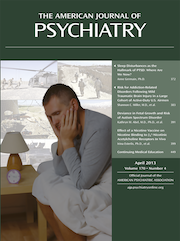Reduced Binding to Nicotinic Receptors After Nicotine Vaccination: Is the Effect Big Enough to Be Clinically Meaningful?
Vaccines against nicotine have enjoyed a lot of publicity in the last few years. One reason may be that the idea of a vaccine for addiction is still novel. In addition, a vaccine implies the prevention or treatment of disease without involving active decision making or willpower on the part of the addict. Antismoking vaccines induce antinicotine antibodies that bind nicotine molecules. The nicotine-antibody complex is too large to cross the blood-brain barrier, so with adequate antibody concentrations, not enough nicotine enters the brain to activate reward centers and reinforce use. Antagonizing the effect of nicotine has shown to work with varenicline, the most effective treatment for smoking cessation to date. Animal studies, particularly in rats, have demonstrated that immunization results in substantially less nicotine entering the brain and attenuated locomotor and other behavioral responses to nicotine (1). In contrast, the sparse published studies in humans that have evaluated different vaccines against nicotine do not currently support vaccine efficacy as a treatment for nicotine dependence (1).
Nicotine exerts its effects largely through the nicotinic receptors of the cholinergic nervous system. These receptors consist of subunits, of which the β2 subunit is thought to be of critical importance. The study by Esterlis et al. in this issue (2) tested the ability of a nicotine vaccine (3′-aminomethylnicotine conjugated to Pseudomonas aeruginosa r-protein, or 3′-AmNic-rEPA) to affect binding to the β2 subunit of the nicotinic receptor. The binding was evaluated in 11 cigarette-dependent smokers with single photon emission computed tomography. The smokers were scanned before and after four monthly immunizations. After baseline scans were obtained, intravenous nicotine (1.5 mg/70 kg body weight) was administered, followed by another set of scans. A maximal binding of 55% of the β2 subunit was observed before vaccination, which was reduced by 11% to 49% of nicotine bound after vaccination. There was a significant increase in antibody concentrations over the course of the treatment to an average of 76 µg/mL. More substantial effects were noted on the area under the curve and maximal plasma concentration (Cmax) of nicotine, which both increased after vaccination, while clearance was reduced.
Although it seems clear that vaccination reduced craving for cigarettes and the number of cigarettes smoked per day, the question remains whether the effect is of clinical relevance. A 12% decrease in binding seems small and unlikely to affect the reward experienced from smoking enough to result in clinical effects. Tobacco smoking is not just about obtaining nicotine (3). Although nicotine probably is necessary for smoking behavior to be maintained, it may not be sufficient. For example, substances in cigarette smoke other than nicotine may play a role in addiction. Nicotine per se is not a very strong reinforcer in animals or humans (4, 5). Furthermore, evidence suggests that abstaining smokers who are experiencing withdrawal symptoms prefer a nicotine-free cigarette to nicotine-containing chewing gum (3). In the smokers’ language, they crave cigarettes, not nicotine. Therefore, an intravenous injection cannot be expected to completely eliminate craving. The situation is similar to that with caffeine: a person wanting a cold soft drink may not be satisfied with a caffeine-containing pill.
Nevertheless, the concept of vaccines against nicotine is appealing. Although clinical results from vaccines against nicotine have not been convincing (1), some lessons can possibly be learned from the work done so far. The following could be ways to improve the further development of vaccines against nicotine: 1) direct more attention and assessment at the function of the antibodies (affinity or avidity), which is largely determined by the antigen, for example, the hapten structure (6); 2) consider novel adjuvants for use in vaccines against nicotine, as they are being used for other vaccine development and have been shown to augment both antibody quantity and affinity (function); 3) switch from intramuscular administration, which has so far been used with all vaccines against nicotine, to other modes, e.g., intradermal administration, which some data suggest could be more immunogenic (7), although skin reactions may limit this approach; 4) use more than one vaccine, which some data (5) also suggest could add to antibody activity, although it is less practical and cost-effective (8); and 5) add monoclonal antibodies to vaccines to provide higher levels of antibodies and less variability between smokers (9). Monoclonal antibodies should result in clinically beneficial levels of antibody earlier, which is considered desirable for clinical practice.
We hope that vaccines against nicotine will prove to be a useful intervention in our toolbox of smoking cessation treatments, but before that happens, several years may pass and much intelligent research needs to be undertaken.
1 : Nicotine vaccines to assist with smoking cessation: current status of research. Drug 2012; 72(4)e1–e16Crossref, Medline, Google Scholar
2 : Effect of a nicotine vaccine on nicotine binding to β2*-nicotinic acetylcholine receptors in vivo in human tobacco smokers. Am J Psychiatry 2013; 170:399–407Link, Google Scholar
3 : Determinants of tobacco use and renaming the FTND to the Fagerström Test for Cigarette Dependence. Nicotine Tob Res 2012; 14:75–78Crossref, Medline, Google Scholar
4 : Transient behavioral sensitization to nicotine becomes long-lasting with monoamine oxidases inhibitors. Pharmacol Biochem Behav 2003; 76:267–274Crossref, Medline, Google Scholar
5 : Reinforcing effects of nicotine as a function of smoking status. Exp Clin Psychopharmacol 2001; 9:243–250Crossref, Medline, Google Scholar
6 : A new strategy for improved nicotine vaccines using conformationally constrained haptens. J Am Chem Soc 2003; 125:7164–7165Crossref, Medline, Google Scholar
7 : High immunogenicity of nicotine vaccines obtained by intradermal delivery with safe adjuvants. Vaccine 2012; 31:159–164Crossref, Medline, Google Scholar
8 : Enhanced immunogenicity of a bivalent nicotine vaccine. Int Immunopharmacol 2008; 8:1589–1594Crossref, Medline, Google Scholar
9 : Monoclonal nicotine-specific antibodies reduce nicotine distribution to brain in rats: dose- and affinity-response relationships. Drug Metab Dispos 2005; 33:1056–1061Crossref, Medline, Google Scholar



